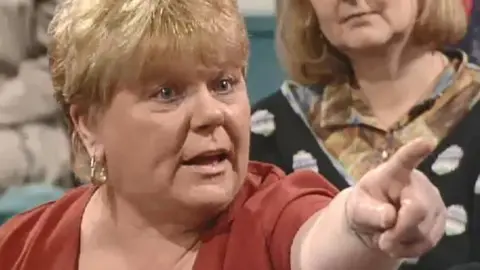The extraordinary tale of Margaret “Big Mags” Haney has captivated and horrified audiences alike, presenting a complex figure that evolved from a public crusader against child abuse to the head of a significant heroin operation in Scotland. This account traces her journey and the subsequent unraveling of her dual identity over the years.
In January 1997, Haney first captured media attention when she successfully expelled a convicted child sex offender from the Raploch housing estate in Stirling, igniting public interest in her actions and her cause. The intense media coverage and her unabashed stance against paedophiles turned Haney into a local celebrity, best known for her appearance on the daytime talk show “Kilroy.” On the show, she passionately argued against the ‘paedophile panic’ permeating communities, showcasing her fierce personality as she confronted members of the audience who sheltered her enemies.
As an anti-paedophile activist, Haney capitalized on her sudden fame, partaking in various protests across the nation, and quickly became a recognizable face. Those close to her, including her granddaughter Cassie Donald, described her as a woman powered by a mix of righteous anger and community spirit, engendering a supportive following who appreciated her fighting spirit. To many, she epitomized a salt-of-the-earth mentality, regarded as a protector of vulnerable families in a time of fear and unease.
However, the brightness of her celebrity was soon overshadowed by the dark reality of her family’s criminal history. Mere months after her public rise, the media shifted focus from her activism to the alarming criminal activities associated with the Haney family. Dubbed “Scotland’s Family from Hell” by tabloids, they were responsible for various violent crimes, drawing scrutiny that would eventually threaten their livelihoods. Mark McGivern, a journalist, shone a light on the family’s extensive criminal activities, noting their legendary notoriety within Stirling.
The tide turned dramatically when local residents, fed up with the Haneys, converged in larger numbers than when they ousted the paedophile six months before. A 400-strong mob descended on Haney’s flat, shouting slogans that demonstrated their intent to drive her out of the estate. In a dramatic turn of events, police intervention was necessary to prevent violence, marking the beginning of Haney’s exile from her community.
Following her expulsion from the Raploch estate, Haney relocated to temporary council housing. Yet, maintaining the media’s fascination, she eventually found herself back on the streets of Stirling, failing to maintain a low profile. In 2000, through a campaign titled “Shop-A-Dealer,” her involvement in the local heroin trade was publicly exposed. An influx of tips revealed her to be a major figure in drug distribution, operating an extensive heroin empire from her residence that garnered significant financial reward.
With the reforms in the public perception of Haney, her status transitioned from a beloved community leader to a feared crime figure. Her drug empire thrived, reportedly bringing in up to £1,000 daily, alongside her monthly benefits from the state. Investigations confirmed that she operated from what came to be informally known as “Haney’s hotel,” highlighting the paradox of her standing within the community.
The inevitable crackdown followed; police launched a sting operation leading to multiple arrests within the Haney clan. Mags was convicted for her leadership role in this drug operation and sentenced to 12 years in prison in 2003. Her daughter and other family members also faced significant prison sentences, leaving the local community reeling from the betrayal.
After her doctors confirmed a cancer diagnosis in 2013, Haney passed away at the age of 70, leaving behind a controversial legacy. Her granddaughter Cassie claimed that while Haney’s actions were contradictory, they were indisputably human. “You can be a drug dealer that has sold drugs that have potentially killed people,” Cassie stated, acknowledging the complexities of Haney’s character as both a grandmother and a criminal.
The journey of Big Mags Haney is one marked by profound contradictions, illustrating the broader conflicts of morality and community justice in a world often grappling with the concepts of guilt and redemption. Her story serves as a reminder of the many shades of human experience, leaving a multifaceted legacy that evokes both admiration and repulsion.











